Menu

Thomas Chippendale Senior was born in Otley, West Yorkshire, in 1718. The son of a carpenter, he was apprenticed into the family trade. At that time in the North of England, much of the finer hand crafted furniture would have been made of Oak.
Although charming, this didn’t easily allow for the sophistication of detail that Chippendale is known and loved for throughout the world today. So at the age of 30, Thomas Chippendale moved to London, the perfect market place to procure exotic hardwoods, and for his work.
He fairly quickly established workshops on St Martin’s Lane, in the heart of London. Covent Garden was bustling with designers, artists and makers. It must have been a very exciting place for the young entrepreneur.
In those days, it might have felt like moving to another country, this was a bold move.

As a cabinet maker and designer, Thomas Chippendale was influenced by the contemporary styles of his day. Especially by a design style referred to at the time as the Modern Style. A style that we later came to know as English Rococo. Rococo more generally, has also been described as the later part of the Baroque period.
Many associate Chippendale with mahogany brown furniture of the highest quality. Chippendale has even been referred to as the High Priest of Mahogany. However there was a great deal more to Chippendale’s work.
Three main styles are commonly associated with Chippendale , Rococo, Chinoiserie, and Gothic, with Neo-Classicism influencing his later designs. One might also argue that the strong curves and design features of Queen Ann furniture influenced his early work.
So whilst no single style is associated with Chippendale, there were very strong, creative and vibrant trends within his work that make it distinctive. You can almost sense the symbiosis of the makers creative drive, and the forces of the fashion.
A unique selection of antique furniture for sale.
What is known today as Chinese Chippendale, ie work in the Chinoiserie style, from the French word for ‘Chinese’, formed an important sub section of his work. Especially his early to middle work.
Such furniture featured fanciful, intricate, carved and painted oriental figures, scenes and designs.
There was a craze for oriental style arts and furnishings during that part of the 17th Century in Britain. So in Chippendale’s work, the Oriental and Gothic elements often blend with the Rococo elements, to produce a distinctive style.

There were many fine cabinet makers and designers of the day, but some key innovations really set Chippendale apart. The middle and upper class were growing. And with them, the demand for luxury items, especially furniture, but also other household items.
Chippendale was a master of anticipating and responding to the needs and desires of his client base.
He not only made furniture. You could purchase Chippendale fine soft furnishings, even coffins. He offered a wide range of interior design features, moulding and the like.
He made it known to his client base, that he was willing to adapt his designs, and to respond to their bespoke needs. He was a responsive marketeer, as well as a world class craftsman and draftsman.
In effect, he was an early master of interior designer. A number of the great houses of the day had interiors designed and adorned from top to bottom by Chippendale and his workforce.

Chippendale was probably the first furniture designer to establish a true brand. A brand famous for impeccable design, workmanship and the use of the best materials.
Within a relatively short space of time Chippendale had 2 premises on St Martin’s Lane, both with substantial workshops, and a workforce of around 50 skilled craftsmen and apprentices working across a wide range of specialities.
From gilding, to marquetry, upholstery, to Japaning: a specialist orientalist style painting technique. Chippendale offered far more than just furniture.
Thomas Chippendale would have done little of the actual furniture making and finishing himself. Although he is known to have handmade a number of specially commissioned items.
He was responsible more for the creative direction and marketing of the business. Also his designs required a diverse range of specialist skills, from gilding to upholstery. So they really required a team.
Before Chippendale’s period, names of periods in furniture design had been attributed to kings and queens, or historical ages.
In some places, especially in North America, people refer to a Chippendale Period. Something no designer had before achieved. And today, just over 300 years since his birth, his furniture continues to smash records, achieving higher pricers at auction than any other furniture pieces.
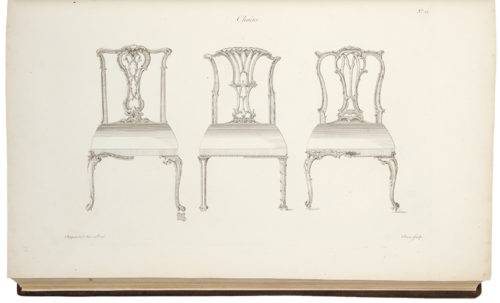
By the 1750s Chippendale had built a successful brand, but in 1754 he released The Gentleman and Cabinet Maker’s Director, which catapulted him to global fame. This was the very first work of its kind.
It was at once a beautiful book including many of his superb designs, the first ever catalogue for prospective clients, and a blue print for cabinet makers.
Essentially it was a set of design blueprints on how to make many types of furniture in his hybrid and intricate style. A style that he described as: furniture in the Gothic, Chinese and Modern Taste.
The Director was a huge success, not only in Europe, but especially in North America. At that time many North Americans still considered themselves British.
This book of designs from the old country was a huge hit; and straight away began to influence furniture makers across the water.
What is referred to as the Chippendale style in the USA, has been injected with different emphasis and flourishes, varying from region to region. There is a great nostalgia still around Chippendale design there today.
It is hard in todays world to emphasise enough just how wildly innovative and creative The Director was. The idea was of course imitated, but this creation of the first ever furniture catalogue, also a world class work of art, was completely original. It truly placed him ahead of the curve.
The Director not only displayed furniture that one could buy, it also gave options, as the picture above illustrates, with its quirky variety of splats & chair leg designs.
Chippendale made it very clear that his designs were available off the peg, or could be adapted and highly bespoke. There was at once an intense creativity, and ability to respond to the needs of clients; within the work.
This was truly unique; and it established him as the greatest furniture designer of his day in a fiercely competitive market.
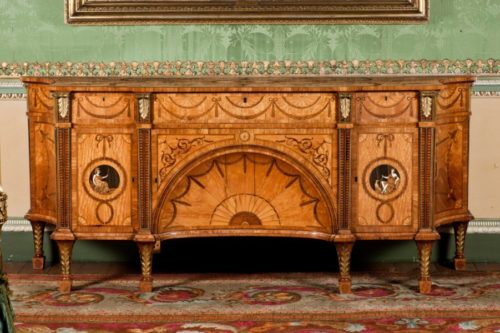
The Director was reprinted the following year, and a third time in 1762 with the edition of Neoclassical designs. Despite his success, by the 1760s he was owed a great deal by some of his wealthiest clients, who he had extended considerable credit to.
The grand houses that he so lovingly adorned were becoming his downfall. With a large family to support, and a substantial number of employees, he had serious cash flow problems. Around this time, Rococo also began to fall out of favour.
A greater number of the middle and upper classes had started to embark upon the grand tour of Europe. A luxury not afforded to craftsmen like Chippendale and his workforce. In doing so they had acquired a taste for all things ancient, and for the simpler, straight, classical lines of antiquity.
Rococo started to feel overly ornate and gaudy to some sensibilities.
Chippendale found himself out of step. So as ever, he was quick to adapt and to integrate elements of Neoclassical design into his work. Often crossing over with his earlier style. He not only re-invented the Director, he partnered with the famous, Neoclassical Scottish architect Robert Adam.
Adam had embarked on the grand tour some years before, and was now designing many of the great houses in the Neo classical ‘Adamesque’ style.
Neoclassicism in a sense was Chippendale Senior’s saviour, and his downfall. It re-energised his business, but in the long term led to more grand projects, and accompanying debts.
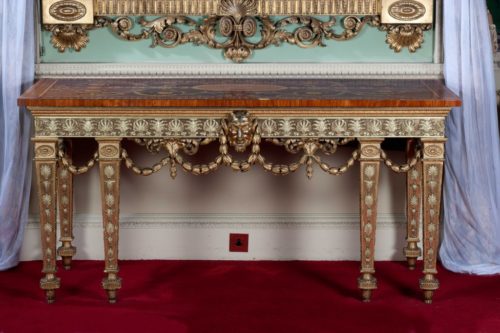
Sadly by the time of his death in 1779, Chippendale’s business was near bankruptcy. Thomas Chippendale Junior, who was already running the firm by this time, managed to turn the family fortunes around. He ran the business again successfully, continuing to design in the Neoclassical style, and later embracing the Regency style.
However the same problem of unpaid debts by demanding wealthy clients continued to plague them, and in 1804 the firm became insolvent.
In their time the Chippendales achieved great things, and left behind a strong legacy that is still alive today. Chippendale is still the greatest single name in British furniture making. Thomas Chippendale brought about innovations that forever changed the landscape of furniture design across the globe.
His original designs are still replicated, adapted and marvelled upon to this day. Thomas Chippendale Senior was buried in the graveyard of the Church Of St Martins In The Field, which now sits beneath the National Gallery on Trafalgar Square.
A unique selection of antique furniture for sale.
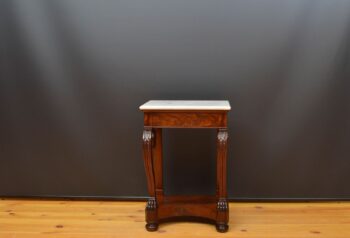 Antique mahogany console table
£2,250.00
Antique mahogany console table
£2,250.00
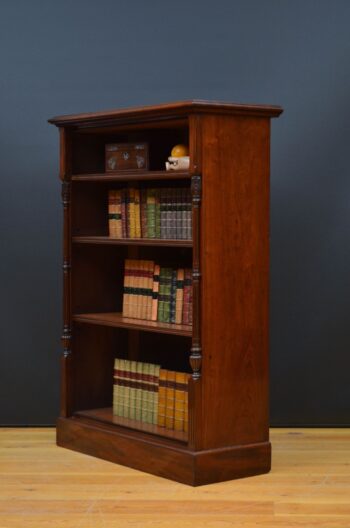 Victorian mahogany open bookcase
£1,685.00
Victorian mahogany open bookcase
£1,685.00
 Victorian Walnut Open Bookcase
£1,650.00
Victorian Walnut Open Bookcase
£1,650.00
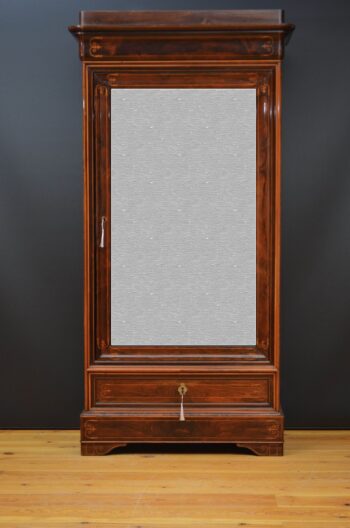 Antique French Rosewood Wardrobe or Bookcase
£2,500.00
Antique French Rosewood Wardrobe or Bookcase
£2,500.00
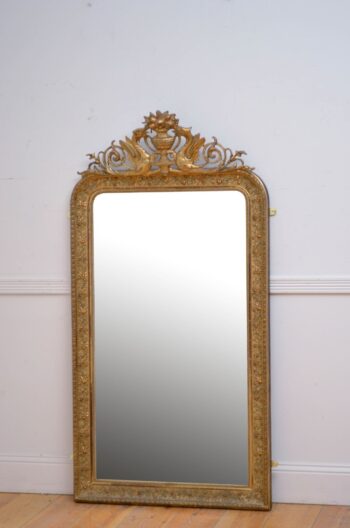 French 19th Century Gilded Pier Mirror H161cm
£2,600.00
French 19th Century Gilded Pier Mirror H161cm
£2,600.00
| Cookie | Duration | Description |
|---|---|---|
| cookielawinfo-checbox-analytics | 11 months | This cookie is set by GDPR Cookie Consent plugin. The cookie is used to store the user consent for the cookies in the category "Analytics". |
| cookielawinfo-checbox-functional | 11 months | The cookie is set by GDPR cookie consent to record the user consent for the cookies in the category "Functional". |
| cookielawinfo-checbox-others | 11 months | This cookie is set by GDPR Cookie Consent plugin. The cookie is used to store the user consent for the cookies in the category "Other. |
| cookielawinfo-checkbox-necessary | 11 months | This cookie is set by GDPR Cookie Consent plugin. The cookies is used to store the user consent for the cookies in the category "Necessary". |
| cookielawinfo-checkbox-performance | 11 months | This cookie is set by GDPR Cookie Consent plugin. The cookie is used to store the user consent for the cookies in the category "Performance". |
| viewed_cookie_policy | 11 months | The cookie is set by the GDPR Cookie Consent plugin and is used to store whether or not user has consented to the use of cookies. It does not store any personal data. |